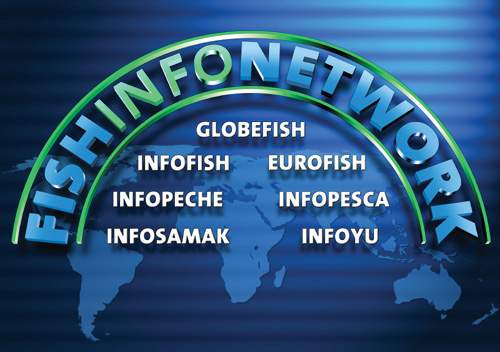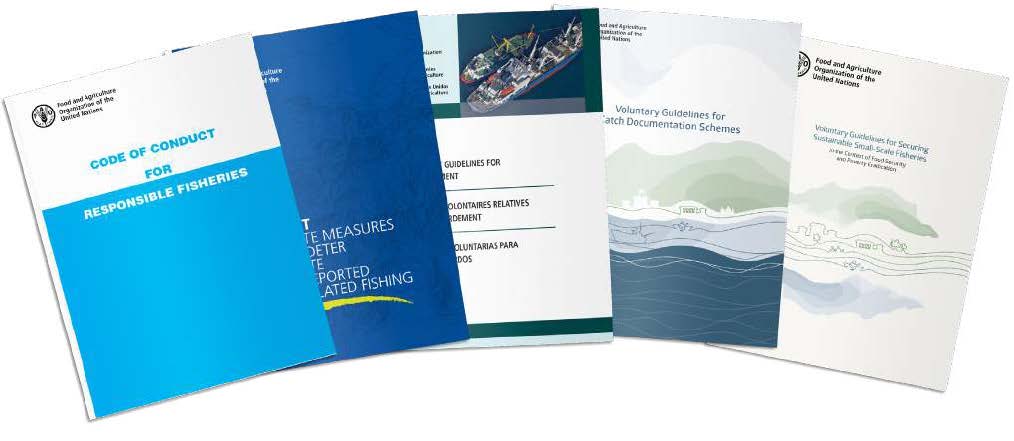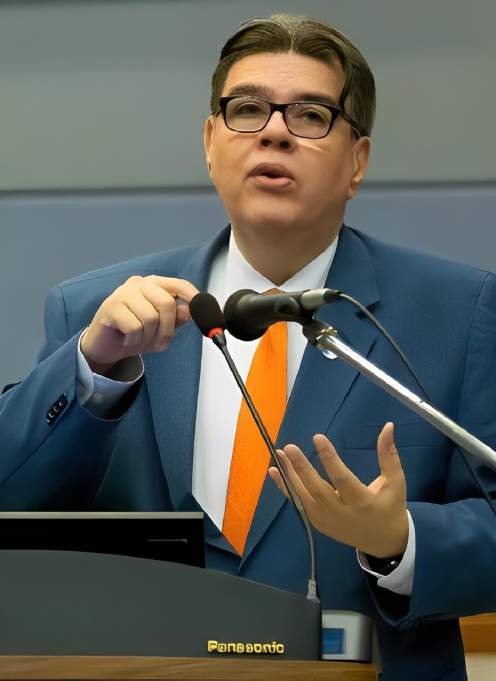Industry Profile: MARCIO CASTRO DE SOUZA
In addition, adhering to sustainability approaches is critical in ensuring long-term food security for future generations of one of the most nutritious protein sources, fish.
Considering the multitude of perspectives and implications of sustainability, FAO has offered governments and the business sector a plethora of tools to foster a favourable environment for responsible fish trade while including sustainability as a central element. The FAO Code of Conduct for Responsible Fisheries, often known as the FAO CCRF, is our most comprehensive instrument and the foundation for all other fisheries and aquaculture FAO instruments, agreements, and guidelines. FAO CCRF was an innovative instrument agreed upon by FAO Member Countries in 1995 during an FAO Committee on Fisheries (COFI) session. Although the FAO CCRF is voluntary, it contains critical principles that governments and the private sector should follow for a long-term sustainable industry. The FAO CCRF addresses various fisheries and aquaculture issues, from pre-harvest to post-harvest, including fisheries management, fishing operations, aquaculture, post-harvest elements, and trade. FAO adopted the FAO CRRF in the same year the World Trade Organization (WTO) was established following the General Agreement on Tariffs and Trade (GATT). The FAO CCRF places a high focus on responsible international trade and the necessity of transparency and avoiding unnecessary barriers to trade, which remain a significant issue in the global market for fisheries and aquaculture goods until now.
Before discussing some FAO instruments, I would like to draw attention to a critical FAO Guideline directly related to the FAO CCRF: Responsible Fish Trade. It offers broad guidance on the specific articles of the FAO CCRF dealing with international trade and related regulations. Although the FAO Guidelines on Responsible Fish Trade are primarily concerned with international trade, they also include critical principles of sustainability.
Of course, FAO has a complete set of instruments dealing with different elements of the fisheries and aquaculture sector. I will try to mention some of the most important ones linked directly with international trade.
When discussing sustainability, it is vital to have exact control over the fish’s origin, movement, and final transformation across value chains. This component is relevant not just to understanding how sustainable your fish is, but also to its legality. FAO provides a collection of instruments to help achieve this goal. The FAO Agreement on Port State Measures (PSMA) is the first global agreement to fight illegal, unreported, and unregulated (IUU) fishing through prevention, dissuasion, and elimination. The FAO PSMA promotes a favourable environment among a network of coastal countries in order to discourage vessels engaged in IUU fishing from utilizing ports and landing their catches, hence establishing obstacles to market entry for fisheries products derived from IUU fishing. More recently, a new FAO instrument improves the effectiveness of the FAO PSMA by providing countries with basic transshipment guidelines: the FAO Voluntary Guidelines for Transshipment regulate, monitor, and manage the transshipment of fish that have not previously been landed.
The FAO PSMA and the FAO Transshipment Guidelines are two important approaches for establishing the legality of fish. They are both reinforced by another critical tool, the FAO Voluntary Guidelines for Catch Documentation Schemes (VGCDS), which uses the concept of traceability to increase information about fish products and their legality. Catch documentation schemes ensure that fish are sourced from captures that comply with applicable standards at different levels along the supply chain. The VGCDS provides guidance to governments and other stakeholders when creating, implementing, standardizing, or reviewing catch documentation schemes.
In addition to these instruments, FAO also has a portfolio of guidances for ecolabels and aquaculture certification.
Q: Along the same lines, the next question is specific to the small-scale fisheries sector. What are some integrated and participatory approaches contained in the Voluntary Guidelines for Securing Sustainable Small-Scale Fisheries in the Context of Food Security and Poverty Eradication (SSF Guidelines) and other FAO documents that states can implement to support the sustainable and inclusive participation of the small-scale sector in international trade?
A: Small-scale fisheries significantly impact a diverse group of people’s livelihoods, nutrition, and culture. They provide almost half of the world’s catch from capture fisheries and employ approximately 90% of the industry’s workers. To comprehensively understand small-scale fisheries, it is necessary to investigate their multidimensional and intersectoral linkages. The SSF Guidelines were a critical step toward framing and making explicit this multifaceted approach. However, in addition to establishing the sector’s overarching linkages, interactions, and demands, we need information and statistics.
To that end, FAO collaborated with key partners to develop the study “Illuminating Hidden Harvests: the contributions of small-scale fisheries to sustainable development”. This study aims to support the implementation of the SSF Guidelines and contribute to a more comprehensive understanding of small-scale fisheries, their importance, and why they are critical to efforts to achieve the Sustainable Development Goals (SDGs).
Small-scale fisheries play an essential role in international trade. Furthermore, when small-scale fishers engage in global trade, the revenue earned gives them access to more balanced and nutritious food, thus improving food security and healthy diets. The study found that smallscale fisheries are heavily involved in international trade, accounting for nearly half of worldwide marine capture fisheries production and exporting almost one-third of all their catch.
However, there are still barriers for small-scale fisheries to access international markets. Small-scale fisheries encounter various issues, including the non-availability of information about overseas markets, product potential unawareness, and food safety and labeling compliance problems. In this regard, FAO is beginning to produce specific information products aimed at small-scale fisheries. To improve the quality of smallscale fisheries’ market access to international markets, all of these challenges must be overcome, and niche markets should be investigated in order to generate potential additional revenue.
Therefore, stay tuned for new FAO items involving small-scale fisheries and international markets.
Q: Trade agreements have evolved to include traditionally non-trade factors such as environmental causes. How do you see these new clauses, particularly from the point of view of developing countries?
A: Indeed, many trade agreements between countries or groups of countries are beginning to include environmental elements as prerequisites for participating countries to gain from selling their products at lower import tariffs and benefiting from a streamlined process. Environmental clauses included in a specific section of trade agreements usually just capture what was already agreed upon in various international instruments. As previously said, the sustainability and legality of fisheries and aquaculture products have become an essential and intrinsic aspect of international trade.
As a result, many exporting countries must seek assistance from international organizations, notably FAO, to comply with these basic environmental requirements. Compliance with such requirements would help exporters reach global markets with high-quality products that may foster long-term commercial ties. It will also help ensure local business prosperity in the long term under the three angles of sustainability. The multifaceted element of fisheries may be seen in various areas, including this one. Holistic approaches are always necessary – to address the challenges and to take advantage of opportunities.
As a concrete answer to disseminate information about these nontraditional clauses, FAO Country Members agreed that FAO should create a database with those clauses to facilitate market access, particularly for small-scale fisheries and developing countries, including least-developed countries. Furthermore, FAO offers comprehensive capacity-building and technical assistance initiatives to help countries meet numerous sustainability fisheries issues, including those associated with new international trade standards.
Q: One of the most important agreements in this regard is the World Trade Organization’s Agreement on Fisheries Subsidies, which identifies that subsidies (or forms of support that embody subsidies) can lead to increased fishing pressure, thus harming fish stock health. The WTO’s 13th Ministerial Conference ended with some progress, including the commitment to “improve the use of the special and differential treatment (S&DT) provisions for developing and least developed countries (LDCs).” Are you optimistic that forthcoming discussions will narrow the gap between developed and developing nations in reaching a consensus on reducing or eliminating subsidies? What will be FAO’s role in this process?
A: The WTO Agreement on Fisheries Subsidies is a significant step toward producing and trading more sustainable fisheries products. The three fish pillars the Agreement addresses—IUU fishing, unregulated high seas areas, and overfished stocks—directly impact fish sustainability and cause trade distortions. Suppose we add the overall mandate of the WTO negotiation process to these agreed-upon fish pillars, which includes overfishing and overcapacity of fishing vessels, as well as the specific needs of developing countries (special and differential treatment) and small-scale fisheries. In this case, we have the ideal scenario for reducing harmful subsidies, which only create sustainability and trade distortions for most fisheries stakeholders. Therefore, more countries must ratify the WTO Agreement on Fisheries Subsidies as soon as possible to implement it fully. The negotiation process should also continue to discuss the missing pillars of the original WTO mandate.
The WTO’s negotiation process is highly unique compared to other international organizations. Multiple sessions of negotiating groups with involvement from all countries can generate a middle ground on which all countries can agree. In the case of fisheries subsidies, reaching a minimal compromise is even more critical because we are dealing with a common good that impacts all countries, not just one. Of course, challenges and different views exist, but in the long run, a middle ground is definitely feasible to reach.
I am indeed optimistic. After many years of negotiations, countries, particularly trade negotiators in Geneva, have come to grasp better and interconnect the various fish concepts and the inputs that numerous international organizations collect on fisheries. Undoubtedly, many of the proposals put on the table are balanced and scientific-based. This is a negotiation process, with some movements forward and others backward. However, accumulating knowledge of fisheries issues and from all national, regional, and global data collections related to fisheries, facilitates the negotiation and reaches a common understanding.
The elimination of harmful fisheries is already a consensus. Countries are now focusing on fine-tuning some flexibilities and exceptions to the fundamental rule of the Agreement. Indeed, we must move forward, and overcoming any divide is indeed possible.
Q: FAO is expected to play a crucial role in the WTO Agreement on Fisheries Subsidies, specifically on fish-related issues. What will FAO’s role be in supporting the Agreement’s implementation? What can countries expect?
A: FAO has an institutional role in the WTO Agreement on Fisheries Subsidies, which reinforces our position as the primary global body dealing with fisheries and aquaculture, unbiased and guided by sciencebased standards.
Additionally, in practical terms, FAO plays an essential role in partnering with the WTO to support countries in implementing the Agreement. For FAO, the overall goal of the implementation phase is to provide countries with capacity building and technical assistance involving existing FAO actions that are directly or indirectly associated with the three pillars of the Agreement (overfished stocks, IUU fishing, and high seas operations outside of any jurisdiction), as well as other supporting mechanisms such as notification.
Implementing the WTO Agreement on Fisheries Subsidies and accessing FAO technical support and assistance can be a significant step forward for some countries in creating or reforming national legislation governing fisheries management, control, and surveillance at multiple tiers within a proper sustainability framework.
Q: Moving on to GLOBEFISH, a project by FAO that you are closely associated with, that has provided information on the international trade of fisheries and aquaculture products since its inception 40 years ago. For the benefit of our readers, could you please give some background on this project, its role in disseminating market information, and what visitors to its website can expect?
A: GLOBEFISH is a really unique and successful project within the Fisheries and Aquaculture Division of FAO. If I remember correctly, it is the FAO’s oldest multi-donor project. In fact, GLOBEFISH is the global market unit of the Fish Info Network, which includes INFOFISH. GLOBEFISH collaborates with the Fish Info Network units to carry out its regionally focused activities.

For its 40th anniversary, GLOBEFISH is introducing a series of new designs for publications and the website to make our information products more accessible, readable, and understandable. We would also like to work closely with our partners and readers to foster sustainable fisheries and aquaculture markets, as well as promote and support regional events with the Fish Info Network units. In the second half of 2024, we will release a specific report on the formation of GLOBEFISH and its interaction with the other units of the Fish Info Network. It will be a fascinating publication, and I encourage all readers to stay tuned for updates.
Q: To end on a glimpse into the future, what key emerging trade-related areas do you feel will only gain importance and urgency? For instance, what do you think seafood global trade systems and governance will look like leading up to 2030?
A: Oh, this is a million-dollar question!
Throughout the interview, I highlighted sustainability from three perspectives: environmental, economic, and social. This multidimensional aspect of sustainability will likely play an increasingly important role in producing and trading fisheries and aquaculture goods.
In general, products must be competitive and meet food safety standards. Nonetheless, there will be increasing demand from private customers in major importing countries, that export countries should observe decent labour conditions in addition to traditional price and quality criteria. And we are not talking about government requirements, but relatively frequent private buying conditions that shape markets.
In the global international framework, the WTO Agreement on Fisheries Subsidies is almost ready to go into effect. We also have the recent Agreement on Biodiversity Beyond National Jurisdiction, which will serve as a new source of support for sustainability on the high seas.
We are all aware that the fish sector is multi-dimensional. For enterprises and businesses to be successful in the long run, the private sector must also consider this multifaceted approach. In addition, governments should continue to encourage and execute sound sustainable practices, considering the unique demands of small-scale fisheries. FAO is always ready to discuss the provision of technical assistance and capacity building to help countries better support national constituencies to maintain long-term business.
I would like to express my gratitude and emphasize that I am entirely available to INFOFISH readers for any clarification or further information they may require. Just e-mail me (Marcio.CastroDeSouza@fao.org). Thank you.

Note: All the publications mentioned in this interview can be accessed and
downloaded at: https://linktr.ee/fishtrade.
These are some of the important FAO documents which provide guidance on fisheries trade, traceability, sustainability of resources, as well as the inclusive participation of the small-scale sector.































